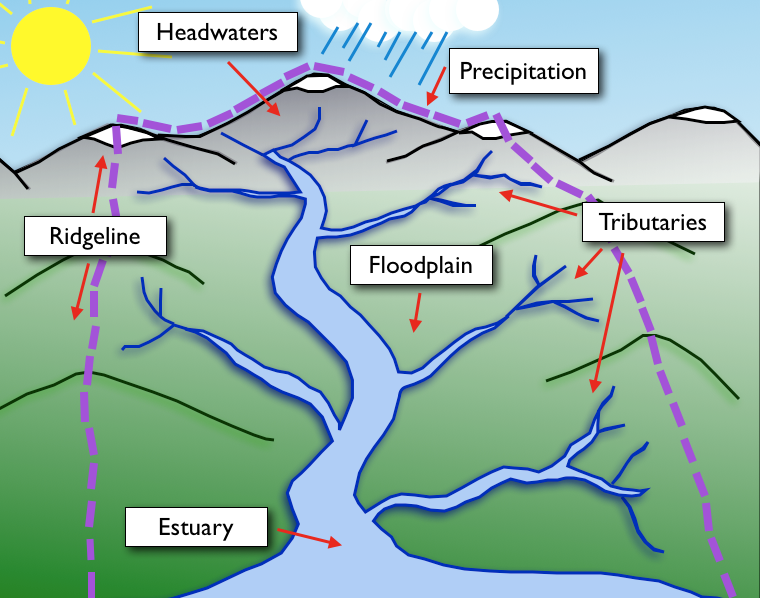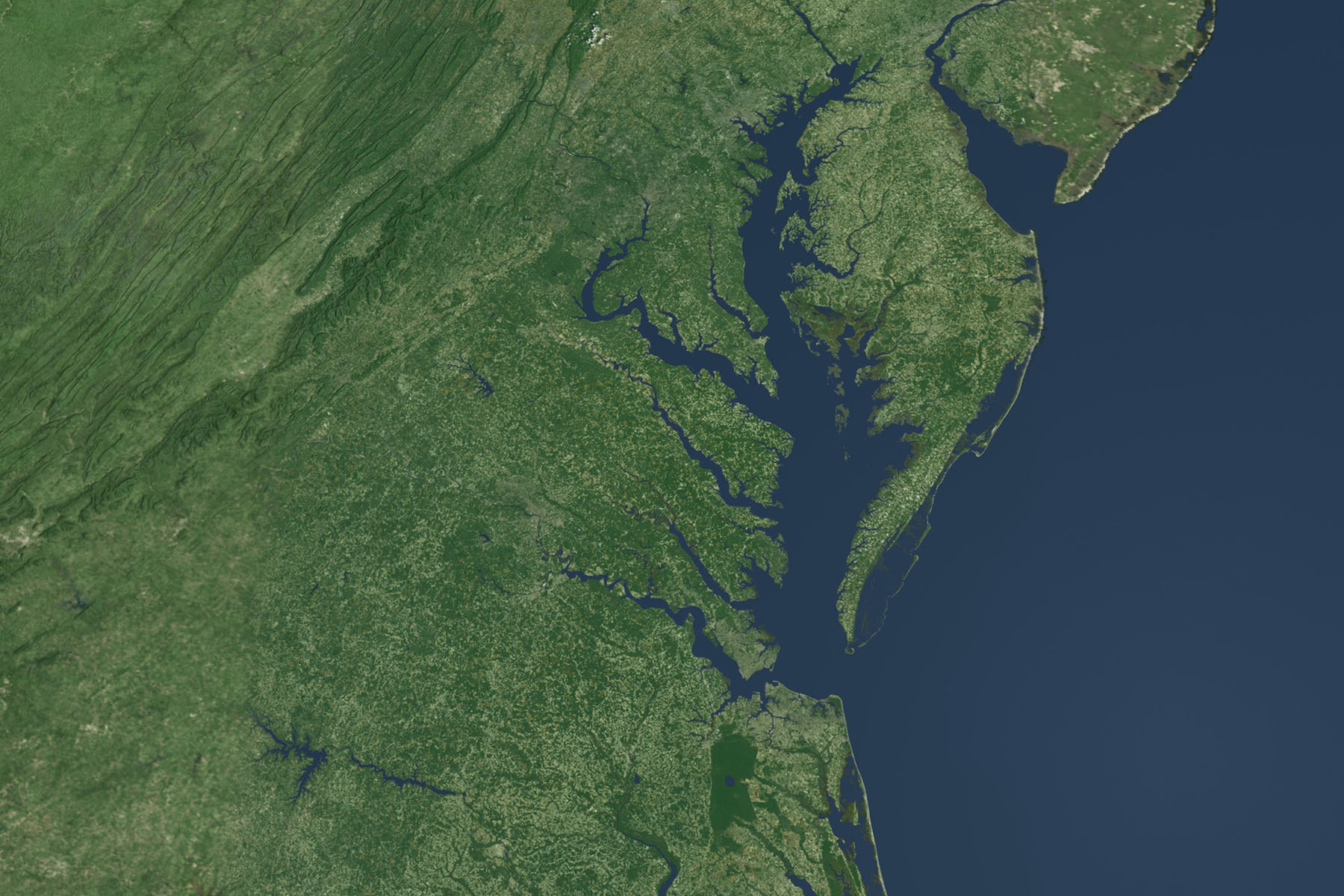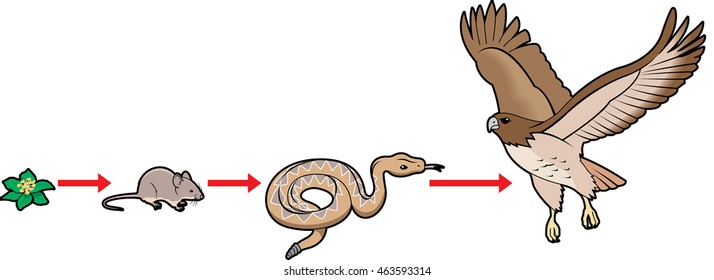 What does this diagram show?
What does this diagram show?
a) River
b) Lake
c) Watershed
d) The Water Cycle
C. Watershed
Which of Virginia's mineral resources is the only resources that is used as a source of energy?
a) limestone
b) granite
c) coal
d) sand and gravel
c) coal
Which is an example of a behavioral adaptation?
a) Giraffe's have long necks to help them reach food
b) Frogs hibernate in the mud during winter
c) Cheetah's can camouflage with their surroundings
d) Frogs have long tongues that help them catch insects
b) Frogs hibernate in the mud during winter
 Who is a producer in this food web?
Who is a producer in this food web?
Plankton

The picture above shows a -
a) community of Zebras
b) Individual Zebra
c) Ecosystem with Zebras
d) Population of Zebras
d) population of Zebras
We live in the _________ watershed.

a) Virginia Watershed
b) Chesapeake Bay Watershed
c) James River Watershed
d) Potomac River Watershed
B) Chesapeake Bay Watershed
Which mineral resource is used in making decorative counter-tops?
a) coal
b) limestone
c) sand and gravel
d) granite
d) granite
Which is an example of a structural adaption?
a) Monarch butterflies migrating in the winter to Mexico
b) Squirrels collecting and storing nuts in their cheeks
c) Butterflies have a straw-like mouth part that helps them suck nectar from flowers
d) Bears hibernate in the winter because it is cold
c) Butterflies have a straw-like mouth part that helps them suck nectar from flowers
Which statement best describes a food web?
a) A food web shows where all animals in an ecosystem live.
b) A food web shows how animals in a community get their energy.
c) A food web shows how animals in a community travel.
d) A food web shows how animals in an ecosystem have different adaptations.
b) A food web shows how animals in a community get their energy.
a) all of the same type of frogs living in a pond.
b) all of the fish, plants, frogs and insects living in the same pond.
c) all of the living and non-living things that make-up an area.
d) The role an organism plays in their ecosystem.
b) all of the fish, plants, frogs and insects living in the same pond.
Which of these would be a natural resource from the Chesapeake Bay?
a) Coal
b) Limestone
c) Pine trees
d) Blue Crabs
D) Blue Crabs
Which is not a natural resource of Virginia?
a) limestone
b) lakes
c) river
d) lemon trees
d) lemon trees would not be found in Vriginia

How does the Eagle's beak help it survive? (Choose the most reasonable answer)
a) It allows it to scoop up fish from the Ocean.
b) It helps it dig for insects.
c) It helps it tear the flesh (skin) of other animals it hunts.
d) It helps it chew berries and nuts.
c) It helps it tear the flesh (skin) of other animals.
 In this food chain, the mouse gets energy from the plant. If the plant becomes diseased, what will most likely happen to the mouse population.
In this food chain, the mouse gets energy from the plant. If the plant becomes diseased, what will most likely happen to the mouse population.
a) the mouse population will begin to decrease
b) the mouse population will increase
c) the mouse population will not be affected
d) the mouse population will start to eat the snake population
a) the mouse population will begin to decrease
(diseased means to die)
(decrease means "go down")
Which would be an example of positive human impact on the environment?
a) throwing waste into a nearby river or stream
b) emptying extra gasoline into a drain
c) organizing a recycling program at school
d) putting harmful waste into your house trash.
c) organizing a recycling program at school
Why is often said, "We All Live Downstream?"
a) Water is connected and flows through a watershed (through streams, rivers, bays, and then to the ocean)
b) Water from the Atlantic Ocean flows to different parts of Virginia.
c) Water from the Chesapeake bay flows to rivers in Fairfax County.
d) All water comes from streams
a) Water is connected and flows through a watershed (through streams, rivers, bays, and then to the ocean)
Which of the following resources might be used to make concrete for construction?
a)limestone
b) sand and gravel
c) granite
d) coal
b) Sand and Gravel
Which animal would not be adapted to live in a forest environment?
a) Black Bear
b) Hawk
c) Penguin
d) Owl
c) Penguin

The sun provides the energy. The grass is a producer, it gets energy from the sun and makes its own food. The grasshopper is a consumer and gets energy from the grass. The Mouse is a consumer and gets energy from the grasshopper. The snake is a consumer and gets energy from the mouse. The hawk is a consumer and gets energy from the snake. The mushroom is a decomposer and gets energy from the remains of dead animals like the hawk. The mushroom provides nutrients to the soil, which makes the plants grow.
What are the four things that all Habitats provide?
Food, water, shelter and space!
If someone dumped paint or gasoline into the Potomac River, what large body of water might it end up effecting?
Chesapeake Bay or Atlantic Ocean
BONUS QUESTION!
If I make a note in my science notebook that a pumpkin as being orange and large in size, am I gathering what type of data?
a) Qualitative
b) Quantitative
a) Qualitative
Mice can be found in cities like New York, or in Forest areas of Virginia. Which of these statements best describes why mice live in cities?
a) They can hibernate during the winter.
b) They can live for many years.
c) They are able to eat many different kinds of food.
d) They have thick fur that protects them from cold weather.
c) They are able to eat many different kinds of food.
Describe one food chain you see within this food web.
Many possible answers!
In an ecosystem each animal has its own Niche. What is a niche?
a) What an animal looks like
b) Where it is located in the environment
c) The role the animal plays in its habitat
d) What the animals likes to do
c) The role the animal plays in its habitat
